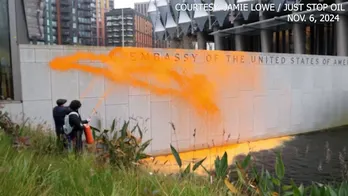Map: After a month of bombardments, as much as a third of Gaza City is damaged
A month into the war between Israel and Hamas, images of widespread destruction, craters and collapsed buildings have become commonplace.
Despite the photos and footage, a comprehensive survey of damaged properties on the ground is impossible at the moment, due to the ongoing conflict.
But new analysis of imagery from the European Space Agency's Sentinel-1 satellite allows for what researchers say is likely to be the most comprehensive look yet at the scale of damage in the Gaza Strip.
On Oct. 7, Hamas-led militants stormed from the Gaza Strip into Israel, killed 1,400 people and took more than 240 hostages, according to Israeli officials.
In response, Israel's military has launched near-continuous airstrikes on the Gaza Strip, killing over 10,000 Palestinians, according to Gaza's Health Ministry, and displacing nearly 1.5 million people, according to United Nations figures.
Since the onset of the war, an estimated 27% to 35% of all buildings in the northern half of the territory have likely been damaged, according to analysis by Corey Scher of New York's CUNY Graduate Center and Jamon Van Den Hoek of Oregon State University. Throughout the Gaza Strip, they estimate that between 13% and 18% of all structures have been destroyed or damaged, a range of 38,000 to 51,500 buildings.
"It's just steadily increasing," said Van Den Hoek, a satellite imagery and remote sensing expert who has been studying this imagery since the war's onset. "There's broad damage in areas where people live — cities, refugee camps."
The Gaza Strip is a narrow section of land situated between the Mediterranean Sea, Egypt and Israel. Its footprint is roughly equal to that of the city of Philadelphia, but with a half million more people, many packed into concrete high-rises in tight cities up and down the coast.
On Oct. 13, the Israeli military ordered all residents of northern Gaza — over 1 million people — to evacuate to south of the Wadi Gaza, a river that roughly splits the Gaza Strip in two. At the time, the United Nations said it would be "impossible" for so many people in Gaza to move without "devastating humanitarian consequences."
Nevertheless, bombing raids have intensified throughout the Gaza Strip, especially in the north where the Israeli military has surrounded Gaza City. The Israeli military says it's fighting to destroy Hamas, which rules Gaza, so it can no longer attack Israelis. Israel, the United States and the European Union have long designated Hamas a terrorist organization.
On Oct. 31, an Israeli airstrike hit the densely populated refugee camp of Jabalia, north of Gaza City. There are news reports of subsequent deadly strikes at Jabalia, which is Gaza's largest refugee camp. Israel has said the attacks killed dozens of militants, including Hamas commanders. The Health Ministry in Gaza said at least 195 people were killed.
It is not known how many residents remain in the northern half of the Gaza Strip. The United Nations estimates that over 160,000 displaced people are sheltering in 57 schools across northern Gaza operated by UNRWA, the U.N. relief agency that aids Palestinians. A further 117,000 displaced people are sheltering in hospitals in Gaza City and northern Gaza, they estimate. The World Health Organization said on Oct. 29 that "evacuation of hospitals is impossible without endangering patients' lives."
The Israeli military has denied targeting Gaza's hospitals. Despite this, Israeli airstrikes on or near hospitals in the northern half of Gaza continue, according to witnesses and international aid groups.
On Friday, Israel struck an ambulance convoy at Gaza's largest medical facility, Al-Shifa Hospital, killing at least 13, according to the World Health Organization. The Israeli military said it struck an ambulance "being used by a Hamas terrorist cell." Israel has said Gaza militants use ambulances to transfer operatives and weapons.
On Monday, two rockets landed near the gates of Al-Quds Hospital in Gaza City, the Palestinian Red Crescent Society said, injuring at least 21.
"We are still seeing extensive, new damage happening in the northern Gaza region," says Scher. The researchers noticed a comparative lull in damage from bombardments between Oct. 25 and Oct. 29, prior to Israel's ground invasion that began at the end of last month. But in the most recent satellite data update, from Nov. 5, damage again appears to be widespread and growing.
South of Wadi Gaza, airstrikes continue, though at a much slower pace than in the north. There, Scher and Van Den Hoek estimate at least 8,900 buildings have been damaged or destroyed, representing about 5% of all structures in that area.
Late on Saturday, bombs fell on Al-Maghazi refugee camp, killing at least 45, according to Gaza's Health Ministry. The Israeli military said Sunday that it was looking into whether or not it was active in the area at that time. Nearby, The Associated Press reports that Israeli airstrikes struck near Bureij refugee camp, killing at least 13.
Gaza's Health Ministry reports at least 52 mosques and seven churches in the territory have been damaged since the beginning of the conflict. UNRWA says 50 of its installations in Gaza have also been hit with airstrikes or bombs, resulting in the deaths of at least 66 displaced people on their properties and hundreds injured.
But as Hamas rocket attacks continue, and artillery shelling and small-arms fire intensifies within the territory, determining the source of the damage detected by satellite imagery becomes increasingly difficult.
NPR's Geoff Brumfiel contributed to this report.
Disclaimer: The copyright of this article belongs to the original author. Reposting this article is solely for the purpose of information dissemination and does not constitute any investment advice. If there is any infringement, please contact us immediately. We will make corrections or deletions as necessary. Thank you.







